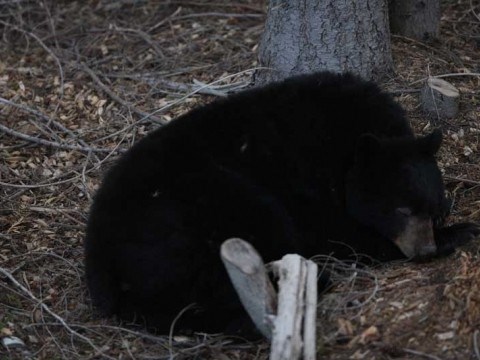The unofficial result of the annual spring (May-June) bear count is a minimum of 71 black bears identified in 120 sq. km of ski area, golf course, and surrounding valley habitats.
The enhanced food supply of the Whistler Blackcomb ski area supports about 70 per cent (18) of the 25 resident females identified in Whistler. The current reproductive potential for the year 2010 in the ski area is 12 breeding and six non-breeding females from a total of 18. This means six females never bred in 2009 (June-July) because they had a total of 15 cubs. And 12 females were observed in copulation from June 17 to July.
The spring survival rate for the 15 cubs was only 68 per cent (10 cubs). Marisa lost one of two cubs, Jeanie lost two of three cubs and Brownie lost two of two cubs. This is the second time Brownie has lost her entire litter - in 2007 she lost three of three cubs.
In 2009, none of this mortality was observed and all cub loss occurred during the peak breeding period, so I am assuming it was adult males killing cubs as a reproductive strategy (to mate with mom).
Other potential sources of cub mortality observed are coyotes (for food), neighbouring adult females (competition), and vehicle collisions.
In 2007, Katie attacked one of Jeanie's two five-and-a-half month old cubs twice, but the cub survived. That was the first observation (by me) of female violence against another female's cub in 24 years.
One cub was struck and killed by a vehicle (reported by government researchers) on Highway 99.
The average size litter of a ski area female is 1.84 cubs so a productive berry season this fall could yield 24+ cubs in 2010.
One of the major factors regulating the cycle of cub production is how productive the berry crop is and thus, how much weight pregnant females gain by November.
We are currently experiencing the down or quiet side of the cycle from a poor berry crop in 2007 followed by low cub production in 2008 and another below average berry crop in 2008. As a result, in 2007 and 2008, 23 bears were removed from Whistler's population (from conflicts with people and non-natural food attractants). That is why it's quiet for bear activity this spring and summer - we have killed a quarter of the population.
It's good to see Whistler Village cleaner but it is not the reason why there is less bear activity in the valley (but we could make it that reason in the future). A true test of Whistler's improved cleanliness (of bear attractants) will come in the fall of 2010 and 2011 when potentially 10-20 sub-adults are dispersing through the valley.
Bears are heading into an above average berry crop but if high temperatures continue, berries will remain small (as heat-stressed berry shrubs compensate), allowing shrivel that much faster. If we do not see a cooling/wet period to slow down berry ripening in August, bears could run out of food by mid-September.
Bears respond to continued high temperatures (> 27 degrees Celsius) by foraging in cooler closed forests (15 vs. 25 degrees Celsius), moving to higher elevations, feeding during nocturnal periods, cooling off in streams and lakes, and avoiding openings during the day.
If you want to see mother bears on the big screen and learn more about their soap opera lives, the Whistler Museum is sponsoring a free public presentation by me at Rebagliati Park (near the covered bridge at Fitzsimmons Creek) on Aug. 1 at 9 p.m.
Questions or to report bear family sightings contact mallen_coastbear@direct.ca




